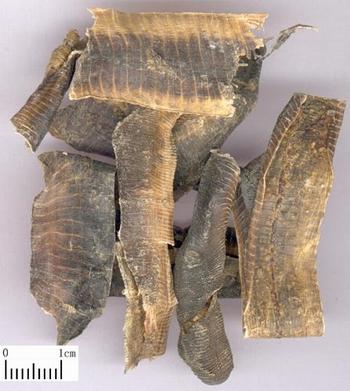Di Long
The Processing of Di Long
Origin
The dry body of P. aspergillum (E. Perrier), P. vulgaris Chen, P. guillelmi (Michaelsen) or P. Pectinifera Michaelsen of family Megascolecidae. The former one is called Guang Di Long, the latter three are called Hu Di Long.
Location
The Guang Di Long is from Guangdong, Hainan and Guangxi provinces in China, and the Hu Di Long is from Shanghai, Zhejiang and Jiangsu provinces, etc. in China.
Harvest
Captured in spring to autumn (Guang Di Long), captured in summer (Hu Di Long).
The actual smell and taste
Fish smell, slightly salty taste.
Best quality
Large, fat, intact and without soil.
Processing
Cut open the abdomen in time, got ride of the internal organs and soil and washed, dried in the sun or low temperature drying; unprocessed or fresh.
The Effect of Di Long
Property
Salty, cold; liver, spleen and bladder meridians entered.
Actions
Clear heat and extinguish wind, unblock collateral, relieve dyspnea, induce diuresis.
Indications
A. Manic-depressive psychosis due to high fever, fright epilepsy and convulsions
Being salty and cold in property, it can clear heat and extinguish wind. For manic-depressive psychosis and fright epilepsy due to generation of wind by extreme heat in epidemic warm diseases, with symptoms such as coma, spasm, convulsions, it is indicated singly or combined with heat-clearing and phlegm-resolving herbs, wind-extinguishing and spasm-stopping herbs and resuscitative herbs, such as Gou Teng, Niu Huang and Jiang Can, etc.
B. Wind stroke
It is good at unblocking collateral. For sequelae of wind stroke with symptoms such as hemiplegia, wry eye and mouth due to qi deficiency, blood stasis, lack of nourishing of channels and obstruction of channels, it is often combined with qi-nourishing and blood-activating herbs, such as Huang Qi, Dang Gui and Chuan Xiong, etc. , in Bu Yang Huan Wu Tang.
C. Arthralgia
With action of unblocking collateral, it is indicated for wind-arthralgia. Being cold in nature, it can be indicated for heat arthralgia with symptoms such as red, swollen, painful joints and limited flexing and extending of joints. It is often combined with wind-damp-dispelling herbs to clear heat and dry dampness, relax tendons and activate collaterals, such as Fang Ji, Qin Jiao and Ren Dong Teng, etc. For wind-cold-damp arthralgia with symptoms such as numbness, pain, limited flexing and extending of joints, it is often combined with wind-damp-dispelling, cold-dispelling and pain-stopping herbs, such as Chuan Wu, Tian Nan Xing and Ru Xiang, etc, in Xiao Huo Luo Dan from Tai Ping Hui Min He Ji Ju Fang.
D. Dyspnea due to lung heat
Being cold in nature, it can clear heat and relieve dyspnea. For dyspnea, wheezing due to heat obstruction of lung and disturbance of lung qi, it can be used singly in powder or combined with lung-clearing, phlegm-resolving herbs and antitussive and antasthmatic herbs, such as Shi Gao, Huang Qin and Ku Xing Ren, etc.
E. Dysuria
It can induce diuresis and clear heat. For dysuria due to heat accumulation in bladder, fresh one is used singly, pounded to pieces, immersed in water, then leached the thick fluid to drink. It is also combined with heat-clearing and diuresis-inducing herbs, such as Che Qian Zi, Chuan Mu Tong and Ze Xie, etc.
Dosage and Administrations
Decoct 5~10 g. Take fresh 10~20 g. Take l~2 g in powder for oral application.
